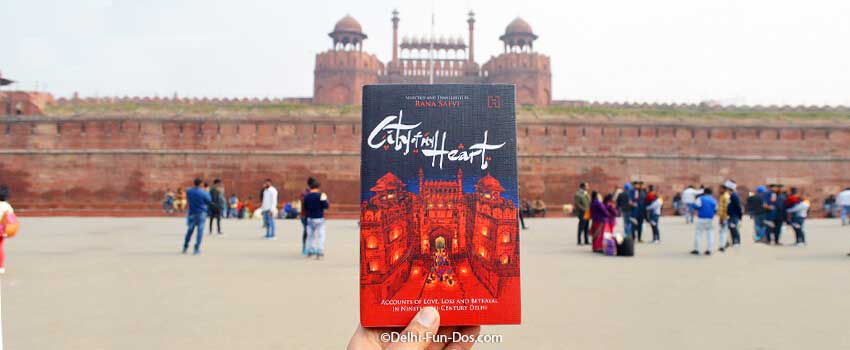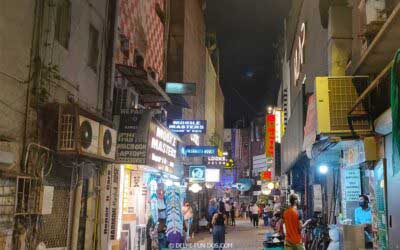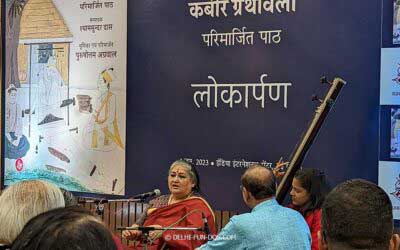
Delhi is a seductive city. You like it or lump it, it is difficult to depart Delhi. Truth be told, we started Delhi-Fun-Dos because we were enamored by life in city and its surroundings. Needless to say, Delhi is the “City of My Heart”. This happens to be the title of the latest book by historian Rana Safvi – “City of My Heart – Accounts of Love, Loss and Betrayal in Nineteenth – Century Delhi”.
Metaphorically, Delhi was hot and happening always. We learned more on this when we attended a walk by Safvi at Red Fort. It was a chilly Saturday morning and we had to get up early to reach the venue punctually. The next two hours were mesmerizing. Safvi led us through the mausoleum as if it was time travel. In the most lucid language, using a story telling style, she told us all about Lal Qila, since its establishment, till the end of Muslim rule post the Sepoy Mutiny in 1857. We knew some of it, specially the history angles. We came to know from Safvi about daily life in the Qila those days. She made it all come true, like a bioscope, in front of her eyes.
That got us interested and we started reading her “City of My Heart” which is about life in Delhi in the nineteenth century. The book is published by Hachette India. It is a translation of four works in Urdu that describe the last phase of Muslim rule in Delhi. These pieces are Dilli ka Aakhiri Deedar (“The Last Glimpse of Delhi”) by Syed Wazir Hasan Dehlvi; Bazm-e-Aakhir (“The Last Assembly”) by Munshi Faizuddin; Qila-e-Mu’alla ki Jhalkiya’n (“Glimpses of the Exalted Fort”) by Arsh Taimuri and Begamat ke Aansu(“Tears of the Begums”) by Khwaja Hasan Nizami.
Red Fort that we see today is barely 20% of the original Qila. Before the plunder of the Fort during Sepoy Mutiny, it was a huge settlement, a mini-city, Safvi, in her book, describes in detail how various festivals such as Eid, Urs, Holi, Diwali and so on were celebrated in the Qila those days. She describes the special menu that was prepared and the food bloggers in us salivate. She vividly describes the decoration at the Diwani-i-Khas, the clothes people wore during festivals and the goodwill among communities when they celebrated with each other. She paints a vivid image of Old Delhi and it is so fulfilling to read about areas and lanes of Chandni Chowk that we still visit for Nagori Halwa and Daulat-ki-Chaat. It is like coming a full circle here.
We don’t read Urdu language so truth be told, we do not know how true is Safvi to the original works. Yet we got goose bumps when we read “There were times when every day was Eid and every night was Shab-e-Barat.” Her love for heritage, culture and architecture oozes out in every page and even on pen, she makes that era come alive. To us, this is a work by Safvi and her narration takes us back to those times when Delhi reached its zenith of glory in commerce, art, culture. And then fell from grace.
While reading “City of My Heart”, we were reminded of William Darlymple’s “The Last Mughal” more than once. The difference lies in the stories that Safvi says in her work. That makes it more of a tale of life, an intimate experience. Safvi has provided copious footnotes and we read those too with interest. But at times, the footnotes take more than 80% of a page. That is cumbersome and somewhat interrupts the reading pleasure. But we did not mind much. This is not a detective thriller, and, we did not read the book at one go. We rather savoured it bit by bit.
To sum it up, “City of My Heart” is a must read for history buffs, anyone who is interested in Mughal or Muslim rule in India or anyone who likes stories drawn from life. The print is most legible and the book is little more than 200 pages. Given that the book is very approachable, you can read the book continuously. It is capable of holding your interest. Or, you may pick up the book and resume reading from any section like we did. Use your own reading style but make sure you enjoy “City of My Heart”. You would surely wish that school history books were written like this.
On our part, we owed reading this book to Delhi-Fun-Dos and we stand enriched by the experience. After all Delhi is our “City of My Heart” not for nothing.




I’ve never been to Dilli, the place looks amazing! Soon i hope. Thank you.
Chad
I sure would love to experience this. I love learning about the history.
Thanks to your wonderful blog I’m falling in love with India!
Great tips! I’ve never been to India, but it’s definitely on my visit bucket list!
Great post! Sounds like an interesting place and that book sounds like an interesting read.
It does sound like such an interesting book. i love hearing about the histories behind some of these amazing places. I would love reading this book.
I am sure everyone will love this place. Interesting read.
I’ve never been here, but I definitely want to go in the future 🙂 thanks for a comprehensive guide and lots of information x
Is this book available on Amazon?